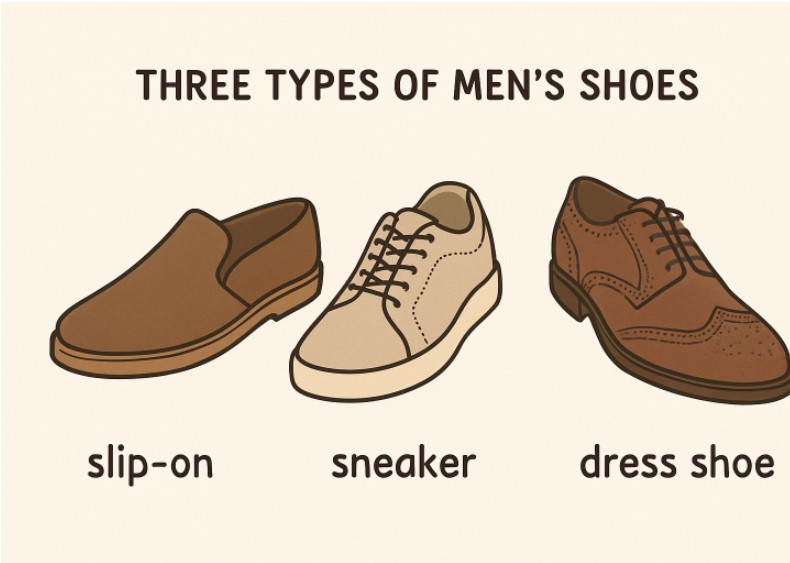Choosing the right pair of men’s shoes is more than a style decision—it’s an investment in comfort, confidence, and long-term wearability. From dress shoes to casual sneakers, the proper footwear supports your outfit and daily activities. However, selecting quality shoes is only half the battle; proper care is essential to extend their life and maintain their appearance. With the appropriate guidance, men can make smart choices tailored to their needs and learn easy cleaning, storage, and upkeep routines. A practical approach ensures your shoes stay sharp, supportive, and ready for every step you take.
The Importance of Proper Footwear
Few investments are as essential as a good pair of shoes in terms of comfort and health. Shoes go far beyond being a fashion accessory—they provide the foundation for your daily activities and overall well-being. Wearing ill-fitting or poorly constructed shoes can contribute to discomfort, fatigue, and even chronic foot conditions, including bunions, blisters, and plantar fasciitis. In fact, podiatrists note that footwear plays a significant role in preventing and managing long-term foot health issues. Starting your shoe selection journey with quality options like men’s slip-ons and sneakers ensures comfort, support, and modern style.
Shoes that harmonize with your individual foot type and walking patterns can promote proper posture, reduce the risk of injury, and help you stay comfortable during long days. From business meetings to weekend outings, high-quality men’s slip-ons and sneakers offer versatility and support for your active lifestyle. Making the right choice at the outset can save you from unnecessary pain and costly health interventions later.
Key Features to Look for in Men’s Shoes
Any man seeking long-term foot comfort should closely examine several essential shoe features. First and foremost, material matters. Natural materials such as leather or high-grade textiles breathe better than synthetics, reducing the risk of odor and irritation while adapting to the shape of your foot over time. Next, pay attention to construction. Shoes with stitched or welted soles generally outlast those assembled with only glue, offering increased durability and easier sole replacement opportunities.
Another vital feature is arch support. Since every person’s arch is unique—ranging from flat to high—finding shoes with adequate support is crucial for overall comfort and injury prevention. A roomy toe box is equally critical. Shoes that allow your toes to move freely help prevent calluses, corns, and painful conditions like hammertoe while accommodating natural foot swelling over the day.
Choosing the Right Shoe for Your Foot Type
Each person’s feet are unique, with subtle differences in structure and movement. Identifying your foot type is key to avoiding discomfort or injury from inadequately supportive footwear. Those with flat feet, for instance, often benefit from shoes with enhanced arch support and motion control features to reduce overpronation. Men with high arches should seek out sneakers with extra cushioning to absorb shock and reduce pressure on the ball and heel of the foot. If you’re unsure of your foot type, visiting a podiatrist or a specialty running store can provide an accurate assessment and suggestions tailored to your needs. Investing in the right shoe type supports not just your feet, but your ankles, knees, and back as well.
Tips for Trying On and Buying Shoes
Finding the perfect fit is as important as picking the right style. Always try new shoes in the late afternoon or evening, as feet swell as the day progresses. Wear the same type of socks you plan to use with the boots to ensure a true-to-life fit. Walk around the store—don’t just stand in place. Look for at least a thumb’s width from your longest toe to the end of the shoe, giving ample space for natural movement. Don’t forget to check that the heel doesn’t slip as you walk and that the boots offer consistent support throughout the arch and sole.
Daily Shoe Care Practices
Extending the lifespan of your shoes relies on consistent maintenance. After each use, brush off dirt or debris to protect the material. When not in use, inserting shoe trees helps maintain the shoe’s structure and absorbs excess moisture from sweat. Rotating between multiple pairs—rather than relying on a single favorite—allows each pair sufficient time to breathe and recover, minimizing odor and extending their longevity. Taking small daily steps makes a significant difference in the quality and appearance of your shoes.
Long-Term Maintenance and Storage
For lasting shoe performance, apply appropriate leather conditioners or polishes regularly to keep shoes looking sharp and feeling supple. If you prefer textile or synthetic shoes, consult the manufacturer’s care recommendations and consider a gentle cleaner to avoid material breakdown. Always store your footwear in a cool, dry area away from direct sunlight, which can cause cracking and discoloration. Replace insoles as soon as they lose their shape or cushioning power, preserving comfort and support season after season.
Knowing When to Replace Your Shoes
No pair of shoes lasts forever—recognizing when to replace them is vital for health and style. Examine the soles for excessive wear or uneven patches, which reduce grip and risk injury. If you experience new or persistent discomfort despite regular care, it’s a sign that the shoe no longer offers adequate support. Noticeable creasing, cracking, or misshapen uppers signal that the integrity of the material is compromised. Knowing when to move on to a new pair keeps your feet protected and your stride confident.
Conclusion
The right shoes are more than a style choice—they’re a daily investment in your health, comfort, and confidence. With careful selection, attentive care, and timely replacement, high-quality footwear can support you in every step of your journey. Next time you refresh your closet, remember the principles of comfort, support, and long-term maintenance—and choose wisely for years of happy feet.
